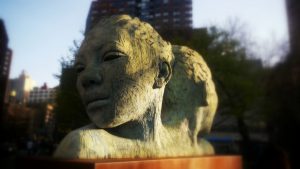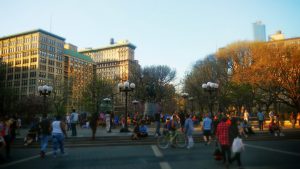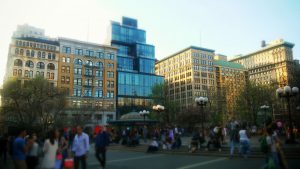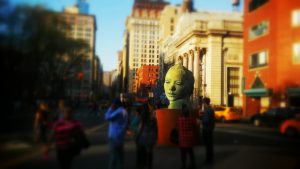When I was around the age of six, I picked out my very first favorite place in Manhattan. It was the first time that I can recall myself creating an instinctual memory of a place; that I knew how to get there from home and what it was called. It wasn’t so much of the architecture that made me like the space so greatly, it was this feeling of the surroundings; like everyone was important and we were all connected. Bias of race, gender, or culture played an inferior role in this particular environment; in fact, New Yorker’s differences were highly embraced and even emphasized. To my young mind the place was my own version of kid-heaven; pets, books, music, diverse cuisine, and other shops were all within walking distance from each other; it was fun, challenging, and I always went home with something new. Although I would loudly and quickly state that my architectural taste has gotten more refined from my childhood, somehow I always find myself in my old favorite spot, Union Square.
The origin of the name, “Union Square”, comes from the Commissioners’ Plan of 1811. Which was a very detailed plan of the roads, streets, and avenues of Manhattan that we still use today. The plan was completed with the help of John Randel, a surveyor, who joined the project in June of 1808 and worked on the development for the next thirteen years. Throughout the years of observation, the creators of this plan coined the name by explaining the intersection of Broadway and Fourth Avenue (previously known as Bloomingdale Road and Bowery Road) which creates an irregular square that no one wanted to build upon so it was decided to make the space a public park. The area was then utilized for social assemblies and trading. The space was formerly called “Potter’s Field” and was later changed to better fit the social aspect of the area; making a union between both roads and people.
The Union Square Park that we know of, officially opened on July 19, 1839; the roads paved, paths created for foot traffic, and the landscape planted to suit the people.
By the 1870’s the Ladies’ Mile shopping district began to form which was a term to describe the long strip of commerce, art, and theater that lined the streets from Union Square Park to Madison Square Park that is on 23rd street (which I mentioned in a past post for the Flatiron Building that resides juxtaposed the Park).
Throughout history Union Square became a meeting space for people to voice their opinion; whether it be in the form of a speech, protest, or gathering. This is the place that people met with each other to show support and respect. In 1861 about two hundred-fifty thousand people gathered on the Square to show their respect after the fall of Fort Sumter (notable Civil War sea fort); this would be the largest gathering of its time. This aesthetic didn’t depart from New York approach. After 9/11, New Yorkers gathered here in response to the crisis; it showed a large caliber of support and condolences; for some time, it was known as a grieving area.
As I walk through Union Square Park now, I still feel the same vibe that I fell in love with as a child. Music, dance, and other artistic performances taking place on the regular; almost as if something is always happening and if you don’t experience it, you are destined to feel an acute absence of what could have been seen, felt, and cherished.

Morphous by Lionel Smit. A South African sculptor who got his piece to be displayed in Union Square from June 13, 2016 to April 30, 2017.








